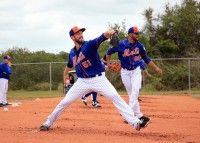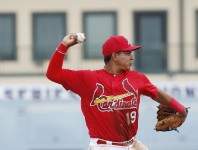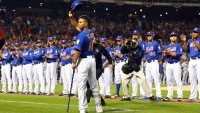Jim Henderson

After Johan Santana threw 134 pitches on a surgery repaired shoulder to throw the first no-hitter in Mets history, Terry Collins was in tears. He seemed distraught. In the post-game press conference, Collins called Santana his “Hero,” and he was prescient in saying:
I’m very excited for him, but in five days, if his arm is bothering him, I’m not going to feel good.
As we know, even though Santana would make 10 more starts, his career effectively ended that night. He would need another shoulder surgery in the offseason. Between that surgery and other injuries, Santana has never pitched in another big league game.
When Collins was interviewed by Phil Taylor of Sports Illustrated three years later, Collins expressed his remorse. He would say, “It was without a doubt, the worst night I’ve ever spent in baseball.” Now, no one really knows what effect this game had on the need for Santana to have a second surgery. However, for his part, Collins thinks the no-hitter had a lot to do with it:
I was aware of what the wear and tear of that night could do to him, and basically, the worst-case scenario happened. To throw that amount of pitches with that much pressure and that much adrenaline going, it can beat you down. And it did.
If Collins truly believes that, it makes what he did with Jim Henderson all the more indefensible.
Henderson has come a long way to get here. He’s had two shoulder surgeries himself. He fought against all odds to make the Mets Opening Day roster. Not only did he make the roster, he quickly established himself as a very important part of the Mets bullpen.
So far this year, Henderson has pitched in five of the eight games the Mets have played. On Tuesday, he threw 34 pitches, which was the most he’s ever thrown in one game. Wednesday was a day game. The Mets added Rafael Montero to the roster so the Mets would have a full bullpen for the game. With the score tied 0-0 in the seventh inning, Collins put Henderson in the game.
Before Wednesday’s game, Henderson’s fastball averaged 95 MPH. On Wednesday, he was sitting around 89 MPH. He allowed a single and two hits before Collins pulled him from a game he shouldn’t have entered in the first place. Collins excuse?
TC: "Henderson said before the game that he felt great."
— Steve Gelbs (@SteveGelbs) April 13, 2016
It’s difficult to believe that Collins used this as a justification. He says he is troubled by Santana’s no-hitter, and he thinks it had a profound impact on effectively ending his career. Why would he willingly do the same thing again with another player? Why would he go to Henderson when there were other, fresher options? It doesn’t make sense.
It should be noted that Collins had a different tone in Wednesday’s press conference than Santana’s. Collins was fired up. There was no hint of him fearing for Henderson’s future.
Collins thought this was a must-win game, but it’s a stretch to believe he would sacrifice a player’s health for it. Collins said he was desperate, but there has to be a line. Collins might’ve wanted to respond to people questioning the Mets effort, but putting a player’s health and career in doubt, you prove nothing.
At the end of the day, Terry Collins has shown he has learned nothing. While we all understood him leaving Santana in, there was no excuse for pitching Henderson there. Collins could’ve ended someone’s career for what really was just another April game. Overall, Mike Vaccarro put it best when he chastised Collins:
Shame on Terry Collins. That wasn't just reckless game managing, but it put his pitcher's health in peril. #Mets
— Mike Vaccaro (@MikeVacc) April 13, 2016
Collins has had some nice moments as the manager of the Mets. Wednesday wasn’t one of them. Collins once called Santana’s no-hitter the worst night of his baseball life. Wednesday could’ve been the worst day of Henderson’s professional life, but Collins showed no remorse. Collins may be haunted by Santana’s no-hitter, but he has clearly showed he’s learned nothing from it.
Editor’s Note: this was first published on metsmerizedonline.com

Tonight’s start by Noah Syndergaard was good. Why do I describe it as good? Because no matter what adjective you would pick to describe his start would be grossly underselling it, so you might as well just go with good. Too bad the Mets offense can’t even be described as putrid. Otherwise, Syndergaard and the Mets might’ve gotten the win tonight.
Syndergaard just dominated the Marlins like he did the Royals – like he’s going to do to the rest of baseball this year. Syndergaard went seven innings allowing seven hits, one earned, one walk, and 12 strikeouts. His ERA actually increased to 0.69.
However, as good as Syndergaard was, he still needed some help. Derek Dietrich would start the inning with a leadoff double, and he would wind up running the Marlins out of the inning. After a ground out and line out, Ichiro Suzuki singled to short, and Dietrich did a poor Eric Hosmer impersonation. Lucas Duda nailed him easily at the plate. Even if Ichiro would’ve been ruled out on replay, it was good to see Duda get some measure of redemption.
However, despite Syndergaard’s domination, the Mets still lost. They lost because the Mets still are not hitting or scoring runs.
The only run was scored on a Duda first inning RBI single. After that, it was pretty much nothing. At least tonight, they had the excuse of a dominant Jose Fernandez for five innings. Yoenis Cespedes gave one a ride in the third, but it was knocked down by the 29+ MPH winds blowing in from left field.
The turning point was Dee Gordon‘s eighth inning sixteen pitch at bat against Jim Henderson. Gordon would single to left. Henderson would walk two of the next three to leave the bases loaded. Henderson just lost his control, and he almost hit Giancarlo Stanton in the head. Jerry Blevins came into the game, and Don Mattingly used Martin Prado to pinch hit. Prado would get the game winning sac fly, and the Marlins would win 2-1.
The Mets have now lost four in a row and are 1-4 at home.
Game Notes: Terry Collins allowed Michael Conforto to hit against a lefty with runners on first and second with one out in the sixth. He grounded into an inning ending double play. Cespedes had another good night at the plate going 1-3 with a walk. Collins ignored the fact that Henderson is playing his first full season since shoulder surgery:
Jim Henderson with his career-high 34th pitch. And it's a walk to load the bases with one out. TC to the bullpen.
— Adam Rubin (@AdamRubinMedia) April 13, 2016

At a time when Mets fans were still clamoring for Yoenis Cespedes, the Mets made a move designed to sure up their bullpen when they signed Antonio Bastardo to a two year $12 million contract.
Generally speaking, the move was well received. While Bastardo was a left hander, he was not a LOOGY. For his career, he actually holds righties to a very respectable .211/.307/.331. Bastardo was a guy that the Mets could slot into the seventh or eighth inning. He was supposed to be a very important part of the Mets bullpen. So far, in 2016, it hasn’t happened that way.
After a terrific stint with the Mets last year, Terry Collins handed the eighth to Addison Reed. After a terrific Spring Training and an even better start to the season, Jim Henderson has locked down the seventh. To date, Bastardo’s role has been much less glamorous.
Bastardo’s first appearance came in a Mets 7-2 trouncing of the Phillies. It was Bastardo’s job to mop up the ninth inning. Last night, Bastardo was called upon to eat up a many innings as he could after Steven Matz only lasted 1.2 innings. Bastardo was the second guy in after Hansel Robles pitched the first 2.2 innings. Essentially, Robles is the seventh or last guy in the bullpen, and Bastardo is the sixth.
Somewhat surprisingly, Bastardo has become the forgotten man in the bullpen. Collins feels more comfortable going elsewhere when he’s looking for a guy to get some important outs. It’s too early to say or suggest that’s he’s in the doghouse, especially since the season’s only six games deep. The fact is Collins feels more comfortable looking to Reed and Henderson. It’s not what anyone had in mind when the Mets signed Bastardo this offseason.
With all that said, there’s still a lot of games left to be played. As the season progresses, Bastardo is going to get some important innings. After he shows this Mets coaching staff what he can do in those situations, he will be put into more and more high leverage situations.
However, until that time, Collins is going to continue looking elsewhere when the game is on the line.
Editor’s Note: this was also published on metsmerizedonline.com
The Mets sent out Steven Matz, who is the proverbial fourth member of what had been touted as the Big Four. Mets fans all hope each of these pitchers will be future Hall of Famers. Tonight, Matz did a pretty good impersonation of Tom Glavine.
Like Glavine, Matz allowed seven runs to the Marlins. At least Matz lasted a little longer. Matz’s final line was 1.2 innings, six hits, seven earned, two walks, and one strikeout. Before the game, Matz was 4-0 with a 2.27 ERA. This year, he’s 0-1 with a 37.80 ERA.
In the fateful second inning, seemingly every Marlin got a hit including Barry Bonds and Don Mattingly got hits. Of course, Giancarlo Stanton provided the exclamation point:
.@Giancarlo818 puts an exclamation point on the 2nd inning!#StantonSmash | #LetsGoFish pic.twitter.com/rTwMWtl5HI
— Miami Marlins (@Marlins) April 12, 2016
It needs to be constantly reiterated, but Bonds seems to be having a very real impact on this Marlins team. Six of their eight regulars are hitting over .300. They had no problem hitting Matz. This is a young Marlins club with a lot of offensive talent. If they realize that potential, it’s a definitive blow to the Mets chances to return to the postseason . . . especially with how this club plays the Marlins.
As for the Mets, their bullpen did a yeoman’s job. Hansel Robles pitched 2.1 innings allowing four hits, one earned, one walk, and three strikeouts. Antonio Bastardo pitched 1.1 innings allowing four hits, two runs, one walk, and two strikeouts. Addison Reed pitched 1.2 innings with no hits, no runs, and four strikeouts. Jeurys Familia was pressed into action even though he has the flu. Jerry Blevins pitched the ninth. The night was such a disaster that Blevins finally allowed a hit in his Mets career. It was an infield single to Dee Gordon with two outs in the ninth.
The Mets might’ve avoided burning through their entire bullpen like that if they would’ve just put Jacob deGrom on the DL. Sean Gilmartin, who was very effective as the long man last year, could’ve soaked up some of those innings. It would’ve been all the more imperative with Logan Verrett going on Wednesday.
Offensively? Well the Mets had seven hits and three runs. All of the runs came after the game was over. Two of those hits were from David Wright, who despite his career being declared over, has been the Mets best offensive player so far this year. He’s hitting .333 with a .478 OBP. Perhaps that’s the reason why the man with the bad back played all nine innings in a 10-3 blowout.
All kidding aside, the Mets decision making in this young season has been perplexing. Terry Collins bats three lefties bunched up together every day (with his splits, Neil Walker is effectively a left handed hitter). Jim Henderson leads the Mets in appearances despite not having pitched in two years and coming off a second shoulder surgery. Remember that next time Collins gets emotional over Johan Santana. At least Collins isn’t to blame for the team’s mismanagement of the deGrom/bullpen situation.
With all that said, this is a game the Mets should just forget about. It’s another game to forget in what has been a mostly forgettable start to the season. Fortunately, momentum is the next day’s starting pitcher, and Noah Syndergaard is scheduled to pitch tomorrow. So, in that sense, the Mets have some momentum going.

As a 26th round draft pick by the Montreal Expos in the 2003 draft, Jim Henderson faced a steep uphill climb to make it to the majors.
He stuck around long enough to be eligible for the Rule 5 draft in 2006. He was selected by the Cubs, but he didn’t make the major league roster. The Washington Nationals didn’t want him back, so he pitched two years in the Cubs minor league system before getting released. He then hooked on with the Milwaukee Brewers organization. He then had to pitch another two and a half years in the minors.
He was 29 when he finally made it to the majors. It’s a plot for a family movie about preserving and accomplishing your dreams. It’s not an indication that you’re going to have any kind of success in the majors.
Yet, Henderson quickly became the Brewers’ closer. In 2013, he recorded 28 saves with a 2.70 ERA. Finally, at 30 years of age, Henderson’s career seemed to be taking off. Unfortunately, disaster struck. Henderson needed shoulder surgery. His 2014 season was over. He only got to pitch 35 innings in the minors in 2015. He was now heading into free agency after not pitching in close to two and a half years.
At that point, he was hoping just to pitch anywhere. Even at 33 years of age, he was willing to pitch anywhere just to get another shot in the majors. He decided to sign a minor league contract with the Mets, who thought fairly highly of him.
He seized the opportunity. During Spring Training, Henderson had a 1.69 ERA with 13 strikeouts in 10.2 innings. Despite yet another steep uphill climb, Henderson proved himself. He made the Mets Opening Day roster. Better yet, he would become a prime set-up man with the Mets.
Terry Collins tabbed Henderson to pitch in the seventh inning to preserve a 2-0 lead against a Royals team that beat up on the Mets team in the World Series. Henderson’s first pitch in the majors after a two and a half year absence was a 97 MPH fastball for a called strike. He would strike out his first batter, Alex Gordon. Henderson pitched a 1-2-3 inning, recording a hold, with two strikeouts.
After all he’s been through, Jim Henderson is not just back in the majors, he’s back to dominate at the back end of the Mets bullpen.
Editor’s Note: this article also appeared on metsmerizedonline.com

When Ruben Tejada was tendered a contract, I agreed with the move. When the Mets released him, I understood the move. He was taking up a spot on the 40 man roster, and there were important roster decisions to make. Now that Spring Training is over, and the roster is set, I don’t understand the Mets thought process.
Heading into the season, the Mets placed Zack Wheeler on the 60 day disabled list. This frees up a spot on the 40 man roster until such time as Wheeler is back and ready to play. This move coupled with Tejada’s release gave the Mets two open spots on the 40 man roster. With Jim Henderson making the team that leaves one open spot on the 40 man roster. That spot has gone unfulfilled.
The Mets could’ve used it to acquire a backup catcher. Rene Rivera, a strong defensive catcher, is a free agent. The Mets decided to bring back Johnny Monell on a minor league deal despite a tough 2015 season. Apparently, the Mets weren’t happy with their choices or with the choices available because they put Kevin Plawecki on the Opening Day roster. Rather than them using the last spot on the 40 man roster, the Mets decided to allow Plawecki reach Super Two status. They are gambling with hindering Plawecki’s development by not getting him regular playing time.
They are also relying on Wilmer Flores being the primary backup to all four infield positions. They are hoping Eric Campbell can be a good bench player like the front office has always imagined he could be. They are hoping that if he falters, or there is an injury, Matt Reynolds could fill-in. They are taking this risk despite Reynolds not having an obvious position to play in AAA with the presence of Dilson Herrera and Gavin Cecchini.
The Mets knew Tejada could adequately play second, third, and short. His presence could’ve allowed the Mets to let Flores get more time at first and third. For reasons now unknown, the Mets decided not to go this way. The Mets decided not to go with a bona fide major league caliber player to be a utility player even though Tejada arguably had the best year of his career when he started the year as a utility player in 2015.
Instead, the Mets let Tejada go to another National League team. If not for his recent injury, he would be helping the Cardinals try to win a World Series. There was a spot for him to do that with the Mets. Instead, the Mets have decided to let that last 40 man roster spot go to waste.
Upon reflection, the only reason it makes sense for the Mets to release Tejada and for them not to add another catcher is money. By cutting Tejada when they did, the Mets saved about $2.5 million.
The Mets are making cost cutting moves that harms the team’s depth despite tickets sales being much better than the Mets thought it would be. The Mets are paring down payroll despite the Mets slightly raising ticket prices.
Yes, the Mets went out and spent the money on Yoenis Cespedes. Yes, the payroll is more commensurate with what a contending team’s payroll should be. However, releasing Tejada is an unnecessary mickle and dime maneuver. He was depth. After last year’s rash of injuries, you would think the Mets wouldn’t take that lightly. He wasn’t taking anyone’s spot on the roster. In fact, they’re not even using all the spots available to them on the roster.
Hopefully, the Mets season doesn’t come down to a $2.5 million decision the team made in March.

Coming into the 2016 season, the Mets should be talking about Erik Goeddel as a lock for the Mets bullpen.
In two years, Goeddel has made 41 appearances. In those 41 appearances, he has gone 1-1 with a 2.48 ERA, 1.000 WHIP, and 9.0 K/9. Advanced stats like him as well. Goeddel’s ERA+ is 150, and his FIP is 2.58. He had a low to mid 90’s fastball, curveball, and a splitter. The discussion shouldn’t be about if he’ll make the roster. No, the discussion should be what inning is he going to get.
So, why is his position on the roster in peril?
For starters, Goeddel is hurt with a lat strain. On Wednesday, he just started throwing from 120 feet to start getting ready for the season. While Goeddel is rehabbing, once long shot candidates like Jim Henderson and Josh Smoker are pitching well in Spring Training games. They are trying to force their way onto the Opening Day roster.
Ultimately, injuries are Goeddel’s biggest problem. He has had THREE TOMMY JOHN SURGERIES! Even with all of that, he still went on the 60 day DL last year with an elbow strain requiring platlet rich therapy. In sum, while Goeddel has the stuff and the results, he cannot be relied upon over the course of a 162 game season.
With everything that has gone against Goeddel in his career, it’s a flat out miracle that he made it to the majors. It’s a testament to his will, tenacity, and yes, talent helped him succeed when he made it to the majors. It’s heartbreaking that when he gets to the majors and succeeds, his elbow betrays him again.
Right now, it’s his lat. He needs to proceed cautiously because any injury to the core or legs can lead to either an arm injury or an exacerbation of an existing arm injury. The last thing anyone wants to see is Goeddel suffer another elbow problem.
So with that, Goeddel may not make the Opening Day roster. He will be heard from this year, but at no point should the Mets count on him going forward.

I’m sure Jedd Gyorko could be the answer to many questions. However, I’m fairly positive he’s not the answer to the question, “Who should be your starting shortstop?”
With the injury to Jhonny Peralta, Gyorko is the Cardinals starting shortstop. Unless the Cardinals make a move, Gyorko will be the shortstop for the next two to three months. Now, Gyorko was never anything more than an average second baseman which a career -1.5 UZR over his three year career. That doesn’t bode well for his chances to be a good to adequate shortstop. Like most, I’m assuming if any team can make it work, it’s the Cardinals.
With that said, it’s a good time for the Mets to call the Cardinals. From all the reports this Spring, it appears that the Mets might be looking to move on from Ruben Tejada. It’s probably the right move too.
Last year, Tejada had an impressive finish to the season. Although never mentioned as such, he was part of the reason why the Mets rallied to win the NL East. His gruesome injury in the NLDS was a rallying cry for the Mets and Mets fans throughout the postseason. However, he’s on the last year of his deal, and he’s an expensive backup eating up a spot on the 40 man roster.
The Mets right now have absurd depth at the shortstop position. Asdrubal Cabrera is penciled in as the starter the next two years. Wilmer Flores grew into the role and handled the position very well when pressed into shortstop duty again in the postseason. Former second round pick Matt Reynolds is competing for a utility role in the majors. On top of that, the Mets have two big shortstop prospects in Gavin Cecchini and Amed Rosario. Long story short, the Mets don’t need shortstop depth.
What they do need is 40 man roster space. So far, Jim Henderson is having a nice Spring and may be on the inside track to locking down a spot on the Opening Day bullpen. The Mets are talking about letting Kevin Plawecki start the year in AAA. This means, as of right now, Johnny Monell would open the year as the backup catcher. There’s a problem with Henderson and Monell making the Opening Day roster.
Neither player is on the 40 man roster, and the Mets have no spots open. Even if the Mets placed Zack Wheeler on the 60 day DL, the Mets would still need to drop someone else from the 40 man roster to add both Henderson and Monell. This could be accomplished by trading Tejada.
It seemed like Tejada turned a corner last year. Unfortunately, with one dirty play he is back on the bench, and frankly, occupying a roster spot the Mets need. It may not seem fair. It may seem cruel, but it’s time for the Mets too move on from Tejada. They should do it now with the Cardinals having a need, and the Mets wanting to maximize the return they would receive for Tejada.
Editor’s Note: this article also appeared on metsmerizedonline.com
One of the fun things about Spring Training is the guy who plays so well, he forces his way onto the Opening Day roster.
In 1996, Butch Huskey hit nine homeruns in the Spring forcing the Mets to make him the Opening Day rightfielder even though he never previously played the position. In 2004, Tyler Yates had a 0.64 Spring Training ERA to get the fifth starter’s job. Yates beat out bigger Mets prospects like Aaron Heilman and Grant Roberts.
These players weren’t even darkhorse candidates to win the positions they ultimately attained on the Opening Day roster. Yet, they were able to win their jobs because they were that good in the Spring. More importantly, the Mets had a spot for these players. The Mets were held competitors for these positions, and these players performed so well that the Mets had no choice but to give them the job.
Looking over the 2016 Mets, there’s only one spot up for competition, and that’s in the bullpen. Right now with Jeurys Familia, Addison Reed, Antonio Bastardo, Jerry Blevins, and Hansel Robles, there are two spots up for grab. The names you’re apt to hear are Sean Gilmartin, Logan Verrett, and Erik Goeddel. Each pitched well out of the bullpen last year and deserve consideration.
Another name that deserves consideration is Jim Henderson.
If you don’t recognize the name, it’s understandable. He’s only pitched in 14 games in the majors the last two years due to a shoulder injury and subsequent surgery. Those 14 games were two years ago when he registered a 7.15 ERA. With all that said, Henderson should not be disregarded. He has a legitimate shot at making the Mets Opening Day roster.
Prior to the shoulder injury, Henderson was a very good reliever. Between 2012 and 2013, he made 97 appearances. He had a 2.98 ERA, 1.180 WHIP, 3.03 FIP, 133 ERA+, and 11.9 K/9. He only allowed 0.9 HR/9. In 2013, when the Brewers made him the closer, he recorded 28 saves.
He can help the Mets. Now that he has completed his rehab, he has a fastball that can touch 95 MPH. He knows how to strike guys out. For his career, he has just dominated righties. He has limited them to .183/.241/.284. At a minimum, he can be a specialist to get out tough right handed batters. Ideally, he can be the Chad Bradford to Blevins’ Pedro Feliciano. In order for that to happen, he just needs to get an opportunity.
Fortunately for him, Terry Collins seems like he is going to give Henderson a legitimate shot. As he told Anthony DiComo of MLB.com:
His history is very intriguing. I know he’s a couple of years out of sugery now, which we’re hoping makes a big difference. I saw him inMilwaukee, and he was very, very good. I’m just hoping we can catch lightening in a bottle.
It’s fair to say, Henderson has impressed Collins. It’s half the battle. All Henderson has to do now is go out there and perform this Spring Training. Like Huskey and Yates, he has to dominate in the Spring. He has to give the Mets no choice but to put him on the roster.
Editor’s Note: this article also appeared on metsmerizedonline.com